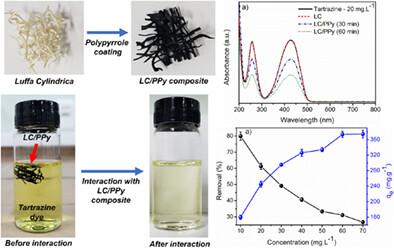求助PDF
{"title":"Use of a Luffa cylindrica/polypyrrole composite for removing dyes from aqueous media","authors":"Maurício F. de Aguiar, Andressa N. R. Leal, Joyce Silva, Gizele G. F. de Andrade, Celso P. de Melo, Kleber G. B. Alves","doi":"10.1002/pi.6563","DOIUrl":null,"url":null,"abstract":"<p>We report the preparation of a <i>Luffa cylindrica</i>/polypyrrole (LC/PPy) composite and its use for the removal of tartrazine dye (E102) from aqueous media. By use of Fourier transform infrared (FTIR) and energy-dispersive X-ray (EDX) spectroscopies, X-ray diffraction (XRD) and scanning electron microscopy (SEM), we were able to confirm that the PPy chains thoroughly coat the LC matrix, with the composite presenting both amorphous and crystalline phases such as pristine LC. We examined the effects of varying parameters, such as the times allotted for the polymerization and the dye–adsorbent interaction, the E102 initial concentration and the temperature and pH of the solution, on the removal capacity (<i>q</i><sub>e</sub>) of the composite. The largest adsorption rate was exhibited by the composite resulting from a 30 min polymerization. At 298 K, the highest value of <i>q</i><sub>e</sub> (374.2 mg g<sup>−1</sup>) occurred at pH 2.0, after 360 min of interaction. The adsorption process occurs spontaneously and is favored by an increase in temperature, with <i>q</i><sub>e</sub> = 672.4 mg g<sup>−1</sup> at 313 K. We determined that the composite could be used in at least five consecutive adsorption–desorption cycles without noticeable losses of properties. Preliminary experiments indicate that good results were also obtained for the removal of the dyes Remazol Black B, methylene blue and toluidine blue. Overall, these results suggest that the LC/PPy composite is a promising material for use in protocols of removal of dyes from aqueous media. © 2023 Society of Industrial Chemistry.</p>","PeriodicalId":20404,"journal":{"name":"Polymer International","volume":"72 12","pages":"1112-1121"},"PeriodicalIF":2.9000,"publicationDate":"2023-07-15","publicationTypes":"Journal Article","fieldsOfStudy":null,"isOpenAccess":false,"openAccessPdf":"","citationCount":"0","resultStr":null,"platform":"Semanticscholar","paperid":null,"PeriodicalName":"Polymer International","FirstCategoryId":"92","ListUrlMain":"https://onlinelibrary.wiley.com/doi/10.1002/pi.6563","RegionNum":4,"RegionCategory":"化学","ArticlePicture":[],"TitleCN":null,"AbstractTextCN":null,"PMCID":null,"EPubDate":"","PubModel":"","JCR":"Q2","JCRName":"POLYMER SCIENCE","Score":null,"Total":0}
引用次数: 0
引用
批量引用
Abstract
We report the preparation of a Luffa cylindrica /polypyrrole (LC/PPy) composite and its use for the removal of tartrazine dye (E102) from aqueous media. By use of Fourier transform infrared (FTIR) and energy-dispersive X-ray (EDX) spectroscopies, X-ray diffraction (XRD) and scanning electron microscopy (SEM), we were able to confirm that the PPy chains thoroughly coat the LC matrix, with the composite presenting both amorphous and crystalline phases such as pristine LC. We examined the effects of varying parameters, such as the times allotted for the polymerization and the dye–adsorbent interaction, the E102 initial concentration and the temperature and pH of the solution, on the removal capacity (q e ) of the composite. The largest adsorption rate was exhibited by the composite resulting from a 30 min polymerization. At 298 K, the highest value of q e (374.2 mg g−1 ) occurred at pH 2.0, after 360 min of interaction. The adsorption process occurs spontaneously and is favored by an increase in temperature, with q e = 672.4 mg g−1 at 313 K. We determined that the composite could be used in at least five consecutive adsorption–desorption cycles without noticeable losses of properties. Preliminary experiments indicate that good results were also obtained for the removal of the dyes Remazol Black B, methylene blue and toluidine blue. Overall, these results suggest that the LC/PPy composite is a promising material for use in protocols of removal of dyes from aqueous media. © 2023 Society of Industrial Chemistry.
丝瓜/聚吡咯复合材料去除水中染料的研究
本文报道了丝瓜/聚吡咯(LC/PPy)复合材料的制备及其对水介质中酒黄染料(E102)的去除效果。通过傅里叶变换红外(FTIR)和能量色散x射线(EDX)光谱,x射线衍射(XRD)和扫描电子显微镜(SEM),我们能够证实PPy链完全包裹在LC基体上,复合材料呈现出非晶相和结晶相,如原始LC。我们研究了不同参数对复合材料去除能力(qe)的影响,如分配的聚合时间和染料-吸附剂相互作用,E102的初始浓度以及溶液的温度和pH。聚合时间为30 min的复合材料吸附率最高。在298 K时,在pH为2.0时,作用360 min, qe达到最大值(374.2 mg g−1)。温度的升高有利于吸附过程的自发发生,在313 K时qe = 672.4 mg g−1。我们确定复合材料可以在至少五个连续的吸附-解吸循环中使用,而不会有明显的性能损失。初步实验表明,该方法对雷马唑黑B、亚甲基蓝、甲苯胺蓝等染料也有较好的去除效果。总之,这些结果表明,LC/PPy复合材料是一种很有前途的材料,用于去除水中介质中的染料。©2023工业化学学会。
本文章由计算机程序翻译,如有差异,请以英文原文为准。



